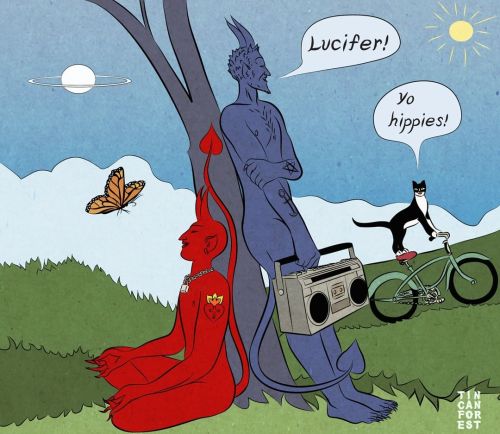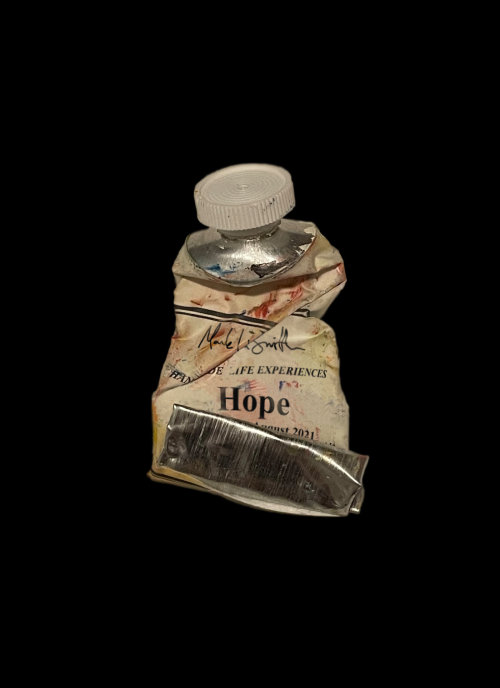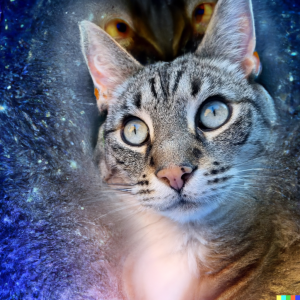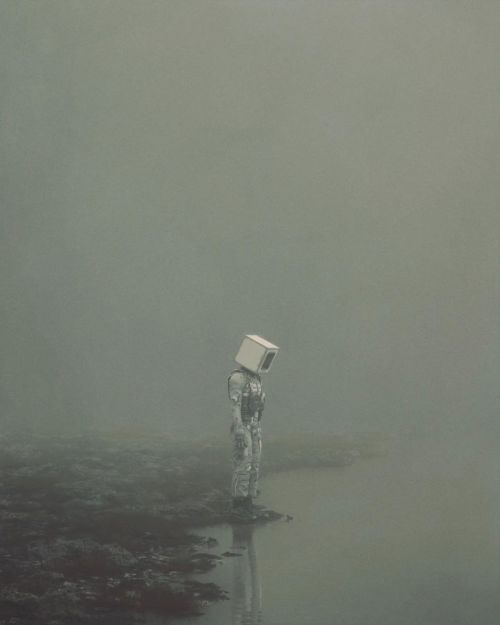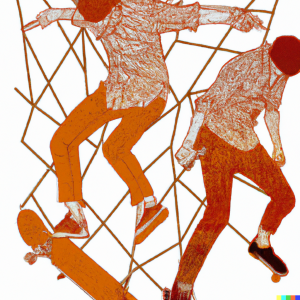Are you aware of the concept of the ‘ratking’? It’s one of those things that’s become popular in the post-web age despite there limited evidence that such a thing has ever existed, but it works so well as a metaphor for so many things that it’s destined to be a part of collective mythology for evermore, regardless of its fictional nature or otherwise.
A ratking, for those of you unaware, is what apparently happens when a large number of rats are left together to breed and live in a small space for long enough, and their tails fuse together to create a writhing mass of claws and teeth and fur and bacteria, leaving the rats unwillingly attached to each other and, presumably, angry and toothy and bitey, and quite liable to turn on each other in an attempt to disentangle themselves from the doomed mass and escape to freedom.
Which is rather what the Government looks like from the outside, a bunch of vermin fused together by prolonged proximity and circumstance and, quite possibly, secreted filth, now turning on itself as the slow realisation dawns on the collective consciousness that the food can’t last forever and the pest control van’s well on its way.
See? I told you this week’s intro would be more cheerful!
I am still Matt, this is still Web Curios, and thank fcuk the web is still full of wonderful things otherwise I don’t know what I’d do.

THE SECTION WHICH ONCE NEARLY GOT ARRESTED AT LIBERAL DEMOCRAT PARTY CONFERENCE FOR SMOKING WEED WHICH DIDN’T FEEL VERY LIBERAL AT THE TIME TBQHWY, PT.1:
- A Slice Of The Pie: It’s ART WEEK! Or at least it is in London, which means…well, for me it means fcuk all, seeing as the days when I used to be able to semi-legitimately blag my way into art world parties and neck as much free booze as possible before anyone realised are well over, but this time of year always causes me to flash back to An Earlier Time when I was younger and had bigger hair and would occasionally end up at launch events and get photographed by Martin Parr whilst holding a cocktail served in a hollowed-out pineapple. Anyway, this link isn’t about London art week at all – out of interest, is there anything interesting being presented from a digital/web art point of view this year? I haven’t seen/heard much, but that’s perhaps down to my own ignorance and lack of anything approaching contemporary knowledge rather than the Absence Of Work – and is instead a work currently being presented in Austria, at the Kunsthalle in Zurich. A Slice Of The Pie is a simple premise – there’s a work hanging in the gallery which consists of a circle divided up into six segments, each of which can be ‘rented’ by a viewer/participant who can pay a small sum (about £1.50, based on this morning’s exchange rate) in cryptocurrency Tezos (it’s ok, it’s one of the less-environmentally-ruinous variants) to fill one or more segments with whatever image or video they want, creating a dynamic(ish) canvas guided by the web, and visible both in-gallery and online via a livestream of the work in-situ. Based on some gentle tinkering earlier in the week, they don’t seem to care too much about what you put on there – so if anyone wants to stump up the maximum fee (around £20 buys you the whole pie to fill as you see fit) to show an advert for Web Curios to a bunch of confused and unappreciative Austrians then, well, you have my blessing.
- The Christie’s NFT Shop: I am nowhere near close enough to any of this to have any sort of idea how the market for NFT art is faring after nearly 24 months of intensely-frothy speculation (and a lot of truly appalling ‘art’), but it doesn’t feel like it’s booming or that anyone who invested hundreds of thousands in a link pointing to a jpeg is feeling like they made a sensible investment. Still, the art world (or at least certain bits of it) spent so much time wanging on about NFTs and investing time and money promoting them as a viable thing (what’s that you say? The art world is a shameless den of grift and naked market manipulation that would make a pyramid salesman blush?) that they have to keep pushing (sunk costs and all that), which is presumably why Christie’s has recently launched its EXCITING NFT ART PORTAL (Christie’s 3.0, apparently, although the website is, perhaps predictably, light on detail as to what the fcuk that number might be meant to mean other than ‘this is where we will attempt to flog you a gif or two’) through which to conduct auctions of not very good clips of mediocre video art (sorry, but). This isn’t super-interesting other than as a snapshot of where the digital/NFT art market has settled in late-2022 after some of the excitement has died down – and where it is is people paying between £6k and £25k for links to some very short video work. Which is…a bit miserable really, if only because (perhaps unsurprisingly) the upshot of all the NFT and Web3 excitement about the art world has essentially boiled down to “it’s another way to sell the same old not-very-interesting work as before, except now we’re just selling a link to it” rather than anything conceptually novel or interesting. Still, if you fancy buying a REALLY EXPENSIVE bit of video to throw onto your smart telly in an attempt to present a veneer of sophistication then you may want to bookmark this.
- Dance Diffusion: And lo! It came to pass that The Great AI Disruption did come for music, and the producers did quake! This is more one to file under ‘watch this space’ rather than ‘the magic is real and here and now!’, but if you’re a bit techy and musically-inclined then this might also be worth experimenting with a bit. This is new from the same people who created Stable Diffusion but is for music instead – the whole project is called HarmonAI (I know, sorry), and you can sign up for access to the community (WHY MUST THERE ALWAYS BE A FCUKING COMMUNITY THE WEB USED TO BE FOR MISANTHROPES FFS) should you wish – the original link, though, takes you to a Google Collab instance with instructions on how to fiddle with it yourself and use it to create short clips of entirely-AI-generated music, and whilst this isn’t the first of these toys to crop up (by any means), its pedigree suggests to me that this might end up being quite good quite quickly. You can read a bit more about the project here should you be interested – this is very much early days for AI music generation, but if it moves as quickly as text-to-image has done over the past 12 months then expect the suicide rate amongst composers of stock music to beginning soaring in around 18 months’ time.
- NovelAI: I imagine that many of you are currently girding your loins and flexing your typing digits in preparation for the forthcoming ORGY OF WRITING that is National Novel Writing Month – this year, why not apply a twist to your (doomed) attempt to churn out a functional work of fiction in 30 days by getting an AI to do all the hard work? NovelAI is A N Other attempt by some enterprising folk to monetise GPT-3 – it’s a paid-for service (albeit with a free trial tier so you can play around with it) with subscriptions costing as much as $25 a month for the bells-and-whistles version, which effectively presents you with a nice front-end to make story creation with GPT-3 simple, letting you do all sorts of things like pick an authorial style, or a genre. There’s a degree of ‘memory’ in the system, with the software able to recall upto 8,000 characters of text (if you pay for the privilege), meaning it’s less likely to throw out stuff that bears no relation to what it wrote two paragraphs ago, and there’s also integration with some image generation software which allows you to churn out illustrations too. I had a quick play around with the free version earlier this week, and whilst I personally didn’t fall in love with it (I think it skews VERY hard towards your standard, online-weebish ‘fantasy and scifi and fcuking elves’ style and chafes slightly if you try and make it do anything a bit more realist-contemporary; either that or I was feeding it garbage, which, honestly, regular readers may well concur is more likely) I can see how it could be super-useful if you’re struggling for inspiration when penning the fifth in your nine-novel epic fantasy fanfiction Doctor Who-slash-Star Wars series (I physically recoiled when typing that, fyi). PLEASE can one of you use this to do NaNoWriMo, though?
- PodcastAI: Welcome to the future, in which we reinvent everything by adding the letters ‘AI’ to the end of it. PodcastAI is (and I imagine you’re there already, but bear with me here) a totally AI-generated podcast! Fcuk knows why you would want such a thing, but it’s here! There’s currently one episode on the website, a simulated chat between Joe Rogan and Steve Jobs (if you want a distillation of some of the reasons why I am so, so tired of certain aspects of technology and web culture, by the way, the choice of those two people works pretty well) which…I mean, on the one hand it sort-of sounds like real people talking, which is undoubtedly impressive (although I’m not familiar enough with either Jobs’ or Rogan’s speaking voices to determine how faithfully they are reproduced), and the conversation flows, but on the other, well, the content is fcuking garbage and seems to just consist of each man simply spouting a few pat inanities as they pass the conversational baton back and forth; it’s a ‘conversation’ in the loose sense that there are two people talking, but there’s little sense that the two interlocutors are actually listening to each other or engaging in proper dialogue – SO IT’S JUST LIKE A REAL PODCAST THEN LOL (sorry)! Here’s how it works: “podcast.ai is a weekly podcast that explores a new topic in depth, entirely generated by artificial intelligence. The episodes are rendered using play.ht’s ultra-realistic voices, and transcripts are generated with fine-tuned language models. For example, the Steve Jobs episode was trained on his biography and all recordings of him we could find online so the AI could accurately bring him back to life.” So there. Obviously it’s churlish of me to complain about a proof-of-concept exercise that is in many respects sort of magical – I mean, the idea that machines can ‘imagine’ and render even half-convincing human chat is astonishing, and this is only going to become more impressive – but I can’t help but be a touch discomfited at the future this seems to presage, one in which all our entertainments are built from the ground up by AI, based on what it thinks we like. What will it look like when the AIs are making things having been trained solely on AI-generated output? I know it’s hideously-unfashionable to mention Infinite Jest in 2022, but I do wonder whether we’re on our way to the creation of exactly that sort of perfect ‘entertainment’ (don’t worry, though, a long way to go!).
- CharacterAI: Honestly, I really do hope this naming trend stops soon. CharacterAI is something that I actually had on the list for last week and then dropped, thinking it looked a bit shonky and not actually that interesting, and then I read this piece describing it and explaining it was built by ex-Google people, and I thought that perhaps I should reconsider. The gimmick with CharacterAI is that anyone can create their own, er, AI character with whom they can then chat – characters can be defined as having specific traits or personalities, so current models include (inevitably) Elon fcuking Musk, and (equally inevitably and significantly-creepier) the AI from the film ‘Her’ which Joaquin Phoenix falls in love with. “Character.AI is bringing to life the science-fiction dream of open-ended conversations and collaborations with computers. We are building the next generation of dialog agents—with a long-tail of applications spanning entertainment, education, general question-answering and others. Our dialog agents are powered by our own proprietary technology based on large language models, built and trained from the ground up with conversation in mind. The Character.AI beta is based on neural language models. A supercomputer reads huge amounts of text and learns to hallucinate what words might come next in any given situation…At Character.AI, you collaborate with the computer to write a dialog – you write one character’s lines, and the computer creates the other character’s lines, giving you the illusion that you are talking with the other character.” Amusingly/not amusingly (delete depending on the extent to which you think stuff like this is potentially dangerous rather than a bit of fun) there don’t currently seem to be any limits on the sort of ‘characters’ you can create using the software, so, er, caveat emptor and all that. It’s worth having a browse through the existing character models that have been created – partly to get a feel for the sort of things that are being explored (lots of fandom stuff, unsurprisingly), but also to be surprised at the numbers – there are bots on here that have racked up literally hundreds of thousands of conversations, which considering this is only a few months old is pretty impressive (or, again, depending on the degree to which you think lonely humans talking to machines is somehow miserable, incredibly depressing!).
- PixelFika: A potentially-useful website sharing examples of high-quality webdesign and copywriting, for all those of you who want an easy, one-stop solution next time you’re asked to come up with a selection of other people’s sites for ‘creative inspiration’.
- MS Designer: Oh look, it’s Dall-E integrated into a Microsoft product! If you don’t think that AI design is going to change the world, then a) you are wrong; b) take a look at this and think again. The idea here is for it to be a simple, easy way of creating images for social media and websites – so banners, avatars, etc – and you can literally see the work pipeline to Fiverr drying up as I type.
- Japanese Restaurant Videos: I have to be honest with you, gentle reader – I went out for drinks last night with some friends, and didn’t get to bed til gone midnight, and somehow woke up at 5am and couldn’t get back to sleep, and am writing this feeling a bit cold and sleepy and it’s all I can honestly do not to throw this video channel to the telly and wrap up in a blanket and just soothe myself to sleep rather than spaffing out all these words that none of you really need or want. BUT I RESIST, FOR YOU! Ahem. Anyway, that’s by way of needless preamble to this GENUINELY WONDERFUL YouTube channel, which as far as I can tell exists solely to profile a bunch of small restaurants in the Osaka area of Japan – each video is presented in lovely 4k, and features people cooking gorgeous-looking dishes (noodle-based, in the main) with occasional cameo appearances by customers and children and cats and, honestly, this is just the most soothing thing in the whole world – no dialogue, just ambient audio and the oh-so-pleasing spectacle of peolpe calmly doing their jobs very, very well indeed. Pleasingly the description for each video not only tells you where each restaurant is, should you ever want to visit, but also tells you what dishes you saw being cooked and, occasionally, how much they cost – if you live in London, you may weep slightly when you see exactly how nice a lunch about £7 buys you in Osaka.
- Ride Review: There are many signs that I am inching closer to death – the vague feeling of senescence, the aches and pains, the almost-certainly-benign-so-let’s-not-check-eh?-lumps… – but perhaps most telling of all is the fact that I can’t help but make a slight, small middle-aged sigh of vague disapproval at the idea of electric bikes, WHY? WHY DO I CARE? E-bikes are good! They encourage people to cycle! They are clean! They are good for cities! Also, I don’t even ride a normal bike so why the fcuk do I care if someone else chooses to ‘cheat’ by having assisted pedalling? And why do I think of it as ‘cheating’?! No idea. Getting old is WEIRD. Anyway, should you be less of a purist w4nker than I am about your velocipedes, and should you be in the market for an e-bike (or e-scooter, or skateboard, or moped, or any one of a number of non-car vehicles that this site covers), this may be super-helpful – Ride Review is basically a review and ratings site for all these sorts of vehicles, which you may find useful when you’re considering dropping a few hundred quid on an urban getabout. Or, alternatively, the fat end of £20k on one of these mad-looking deathtraps that would absolutely get you killed after six minutes on the North Circular.
- Talk To Books: This is a fun idea, made by Google (and found via the lovely Nag On The Lake) – Talk To Books doesn’t actually let you talk to books, obviously (you don’t need the web to do that ffs, chat with your paperbacks whenever you like!), but instead acts vaguely like a sort-of conversational search engine. Type in whatever question is currently troubling you – “What is the most evocative smell?”, “What does love feel like?”, “How do I stop worrying about the inevitability of my death and overcome my innate fear of the fact that we are all made of meat and gristle and, occasionally, hatred?”, that sort of thing – and the wite will spit out a bunch of quotes from GREAT WORKS to inspire and guide and educate. This is, honestly, really rather nice, and works both as a fun little literary toy and a good way of finding topic-specific quotes that haven’t already been done to death.
- Dorsia: To be honest I am including this largely because of the name – a MILLION Web Curios points to any readers who get the reference here (Curios points can be redeemed for more links next week) – but there’s also something interesting about the idea at the heart of this app, which basically exists to let rich people jump the queue for restaurants by guaranteeing that they will drop a minimum amount if they get given a table. Which is, obviously, horrible – let’s add another layer of rich-person-only exclusivity to a scene which is already expensive and exclusionary! – but also feels very, very ‘now’ and like the sort of thing that will eventually cross the Atlantic and land in London. This is currently only in NYC, but it claims that it’s expanding to LA and Miami (obvs) in due course – will be interesting to see whether it gains traction.
- The Hummingbird Clock: You’ll want to mute the tab as soon as you open it, FYI, but this is a genuinely-interesting thing that I learned about this week and which I now share with you. The Hummingbird Clock is an art project made six years ago for Liverpool Biennale, but which I have just discovered: “The UK national electrical grid delivers power across the country. This mains power supply makes a constant humming sound, yet there are tiny changes to the frequency of this sound every second. Most recordings made in the UK have a trace of mains hum on them and this can be forensically analysed to determine the time and date they were made, and as a result, whether anyone has edited the recording. For over ten years, the UK government has used this technique as a surveillance tool. This is the Hummingbird Clock, an online time piece that aims at making this technique available to everyone.” So the clock tells the time, but also plays the sound of the National Grid which is…weird, but also sort-of cool. Beautifully, the project also offers you the chance to accurately date/timestamp any audio or video from the UK since 2016 – just submit the file and they will do the rest, which for any of you desperately needing to prove that you were or weren’t in a specific place at a specific time could be hugely useful (Web Curios obviously doesn’t judge, but obviously believes in you and your innocence).

THE SECTION WHICH ONCE NEARLY GOT ARRESTED AT LIBERAL DEMOCRAT PARTY CONFERENCE FOR SMOKING WEED WHICH DIDN’T FEEL VERY LIBERAL AT THE TIME TBQHWY, PT.2:
- The Design Generator: “The Design Generator is a text-to-image AI trained on images of the V&A’s collection. Using prompts that combine key terms from the V&A’s collection categories (periods, styles, materials, techniques, etc.) it can generated new, imagined museum objects.” So there! This is the Twitter feed of said AI, which was spitting out the resulting images up until the end of September and then seemingly…stopped, which seems a bit rubbish frankly given the infinite generative capabilities of AI and the fact that you could literally automate the creative-generation-to-Twitter pipeline with very little work whatsoever. Still, here’s hoping that this gets resurrected as there’s something rather nice about having the day’s doomscrolling interrupted by a totally imaginary piece of decorative 18th century earthenware.
- Wildlife Photographer Of The Year: Yes, ok, fine, every single newspaper website in the world will be running a selection of these today, given the winner was announced last night, but here’s the link to ALL OF THE PHOTOS for you to gawp at should you so wish (personally I find looking at them online far more pleasant than the inevitably-oversubscribed physical exhibition at the Natural History Museum). As ever with this award, the photography is amazing and pleasingly-clear-eyed; it’s nice to see a nature photography prize that acknowledges the fact that death is part of life, and also one which doesn’t shy away from documenting all the various multifarious ways in which we as a species have perhaps been less-than-lovely to our lovely animal chums over the millennia. That said, if you’re the sort of person who would prefer not to see any images of animals in distress then perhaps scroll carefully and be prepared to look away. My personal favourite this year is this shot, a Cuban guy feeding a bird with a seed from his mouth, but, honestly, these are uniformly astonishing.
- Voicy: Has this been around for ages? It rather feels like I should have seen it before, but, well, I haven’t. Voicy is basically ‘Giphy, but for audio clips’ which on reflection isn’t something I can ever imagine anyone wanting, but still it exists. You can search clips, browse them by category, download them and use them however you wish – which strikes me as s the sort of thing which isn’t entirely ok from a copyright perspective, but if you’re after a free library of audioclips and sound effects and snippets of dialogue then it might be of interest. As far as I can tell a large proportion of this stuff is being created by children and is being used to make stuff in Roblox (fx for user-created games, that sort of thing), which means that the quality of clip on there is…questionable at best, but there’s something quite fun about the sheer oddity of the range of stuff on here (also there’s a whole soundboard of Pingu sound effects, which is never a bad thing).
- OpenPeeps: Oh this is a GREAT idea (via Blort) – this is an open source library of line-drawn people, available to download, and all modular, meaning that you can mix and match faces and hairstyles and arms and legs to create exactly the sort of illustrated individuals you want, allowing for a diverse range of characters which all have a recognisable style. It’s SUCH a great resource for anyone who needs/wants to create something using character art, and the fact it’s all available under an ‘anything goes’ Creative Commons license is all the better.
- The Syrian Cassette Archives: WOW. This is such an incredible resource and you could basically lose yourself in this until next week’s Curios without coming up for air. You ever wanted an incredible, exhaustive compendium of Syrian music as available on cassette tapes sold from small Damascene stalls in the late-20th/early-21st-Century? GREAT! The Syrian Cassette Archives is “an initiative to preserve, share and research sounds and stories from Syria’s abundant cassette era (1970s-2000s). We invite you to explore and immerse in the many sounds and images of the digitized cassettes as you navigate the site in Arabic or English. In our Features section, you’ll find specially produced audio, visual and written works developed by the SCA collective and its collaborators, including interviews with musicians and producers from the era, curated audio features and written contributions from a variety of writers and researchers.The growing collection features an overview of musical styles from Syriaʼs many communities and neighbors, including Syrian Arabs, Assyrians, Kurds and Armenians, as well as Iraqi cassettes and music from Iraqi’s that had been displaced by sanctions and war. Amongst the tapes are recordings of live concerts, studio albums, soloists, classical, childrenʼs music and more, with special focus on the regional dabke and shaabi folk-pop music, performed at weddings, parties and festivities. At the heart of the site’s initial collection are hundreds of cassette tapes purchased at music shops and kiosks throughout Syria by producer and archivist Mark Gergis during multiple stays in the country between 1997-2010.” The music fcuking slaps, as does all the cover art – honestly, this might on reflection be my favourite link of the week.
- The Small World Photography Contest: More photographs! This time of REALLY SMALL THINGS! We return for another year to Nikon’s ‘Small World’ photo competition, which once again showcases some of the most impressive examples of photomicrography (I am happy to type that word, but please don’t ask me to tell you what exactly it means) from around the world. These are quite beautiful, although good luck working out what any of the images are of without clicking and reading the associated descriptors – do make sure to cycle through the different categories using the links at the bottom of the page, as the ‘highly commended’ and other non-prizewinning images are also wonderful (including this lovely one of a rat embryo, which isn’t a phrase I’d expected to type when I woke up 4 hours ago).
- The OEC: My work doesn’t tend to involve me having to look at hard data about international trade, which is good as I would neither understand nor care what any of the numbers mean. Still, this site impressed / intimidated the hell out of me, and I imagine if you’re someone who does occasionally have to think about international trade and imports and exports and stuff like that (can you tell that I honestly don’t understand the first thing about business? No fcuking clue, honestly) then you might find this useful (or, perhaps more likely, you already know about it). “The Observatory of Economic Complexity (OEC) is an online data visualization and distribution platform focused on the geography and dynamics of economic activities. The OEC integrates and distributes data from a variety of sources to empower analysts in the private sector, public sector, and academia.” I have no idea how interesting or useful this might be to you, but I was momentarily fascinated to look at all the data on the UK and to find out that in 2020 we were the world’s largest exporter of ‘hard liquor’, which I feel isn’t something we shout about enough tbh.
- Parties Started: A Twitter account which, fine, won’t be the most active that you follow but which is very much worth keeping an eye on – this will Tweet every time a new political party is registered in the UK. Which is how I know that we can all look forward to the ability to vote for the “Workers Voice UK” party in the next election, and that the party previously known as ‘The Children and Family Party’ (sounds a bit sinister) has changed its name to “Justice for Men & Boys” (sounds even more sinister and I sort-of wonder what happened to cause the change – I imagine she ‘took the kids, Dave’, but I’m just speculating here). Anyway, if you want to keep up-to-date with exactly when the first bunch of Tories jump ship and set up ‘The Continuity Conservatives’ or somesuch, watch this space.
- Musk Messages: I imagine that most of you get your fill of Elon simply by existing – I understand, of course, the public fascination with the world’s richest man, I just wish he seemed…more deserving of said fascination. However, if you are itching to do a deep dive into all the texts that were made public around the “will he/won’t he?” (so bored of it, so want it to be over) Twitter acquisition and see exactly how banal his conversations with a bunch of other rich people desperately attempting to engage in some amateur nasal proctology are then this website will see you right. It’s been said before in discussion of these messages, but it’s a staggering window into quite how unremarkable the people running tech/VC/the world really do reveal themselves to be up-close – there’s nothing in here that you would describe as particularly smart, quite a lot that is self-evidently quite stupid, and everything points to the depressing fact that, no matter how rich and successful you are, there is always someone richer and more successful than you that you want to ingratiate yourself with. We really are just primates with pretensions, honestly.
- The Descent of the Serpent: A nice little bit of ludic edutainment from Google, with this small ‘game’ (it’s only a game in the loosest sense of the word, but it’s cute and fun and so it probably gets away with it) which does a nice, light-touch educative job of telling kids (or frankly anyone, but I think the sweet spot here will be for children of about 9-10) all about the history of Mesoamerica. Wander around, talk to various historical figures, gloss over all the stuff about human sacrifice…it’s like a very small, very worthy Zelda, sort-of, but with more unpronounceably-concatenated consonants.
- Splitter FM:. This is a really interesting idea which rather needs some more high-profile artists to properly take off. Splitter’s a service where artists can upload song stems for their work, thereby allowing fans (or just the curious) to mess with them to remix and rework existing tracks and make new material from the raw. This is LOADS of fun to play around with, as anyone who’s messed about with this sort of thing in the past will know – it’s also sadly lacking any artists who I’ve actually heard of (aside from long-time internet favourites Pomplamoose), although that may be a result of my being in my mid-40s and my musical tastes having long-since atrophied. Anyway, this is a really fun site to mess around on, but if any of you happen to work with any artists I actually like could you please persuade them to sign up for this so that I can produce my own tin-eared manglings of their back catalogue? Thanks!
- Manhattan Population Explorer: As ever with this sort of New York-ish stuff I am including this mainly because I wish there was a version that did the same for London. This map shows you the distribution of people around the island of Manhattan over the course of 24h, with density represented by bar charts to create a rather pretty topography. “The visualization you see here is a model of the dynamic population of Manhattan, block-by-block and hour-by-hour for a typical week in late Spring. The model is currently fixed to your local time. The population estimates are the result of a combination of US Census data and a geographic dispersion of calculated net inflows and outflows from subway stations, normalized to match population daytime and nighttime estimates provided by a study from NYU Wagner.” So, er, can someone build this for my home city now, please?
- Hahahahahahaha: A small webtoything, which would be literally PERFECT if only it had sound (but it doesn’t, and so is just ‘pleasing’. AIM HIGHER, ANONYMOUS WEBPERSON WHO CERTAINLY DIDN’T MAKE THIS LOOKING FOR MY APPROVAL!).
- If You Lived: OK, I confess to not totally understanding what’s happening here, but I think that the gimmick is that the page is effectively mimicking the processes happening in a living body in realtime, but as back-end code functions. Look, this will be a lot simpler if you just click the link and follow the onscreen instruction – done that? Good. Do you see now? DO YOU SEE? I think this is quite beautiful, in a way I can’t quite put my finger on, and I would like to see it as a big, permanent thing in a public space (my word, I am FULL of never-to-be-fulfilled wants this week, it must be the lack of sleep).
- Kevin Costner’s Waterworld: Finally in this week’s coveted ‘it’s the end of the miscellanea section, have a videogame!’ slot, KEVIN COSTNER’S WATERWORLD! Which you obviously are all aware is in fact a very small gag in the Simpson’s, where Milhouse plays approximately 3 seconds of the arcade game in question and dies immediately, and which has now been turned into an ACTUAL, REAL VIDEOGAME! This requires you to download and install it, but it’s small and it’s free and it will give you approximately 15 minutes of genuine (if frustrating and janky) joy, which is more than you can probably say for whatever bullsh1t ‘job’ you are currently pretending to care about. This is actually quite smart – the difficulty comes in that you are not controlling the game, you are controlling Milhouse’s arms controlling the game, making the whole thing an exercise in slightly-awkward metacontrols, but it’s worth persevering because there are quite a few solid gags in here and it’s an enjoyable play in a ‘ridiculous and shonky but good’ sort of way.

THE CIRCUS OF TUMBLRS!
- The Modified Body: I was reminded earlier this week of being a lobbyist in the mid-00s and being so bored and hating my job so much that I basically took to browsing the most overtly-NSFW content I could in the office (no bongo, obvs, I’m not an animal), which much of the time was the website of body modification publication BMEzine. Which meant that I saw a LOT of hooks-in-skin and suspensions and people ecstatically bleeding on each other – which is exactly what you’ll get from this site, showcasing both examples of body mods from around the world and throughout history, but also some more modern examples including scarification and suspensions and all that jazz. Obviously if you don’t want to see pictures of people’s skin being pierced by large hooks, don’t click this one.
THE TROUGH OF (INSTA) FEEDS!
- Daniel Lazo: Daniel is a designer who works on films and as far as I can tell designs scifi-style user interfaces for imagined futurestuff – this Insta feed collects some of his work, and it is GREAT and make me wish that I wasn’t going to be long dead by the time stuff that looks like this is in circulation.
- Automotive AI: “Automotive designs from a parallel universe, brought to you by artificial intelligence”, because concept car designers have no place in the AI future either.
- Harry F Conway: I was in Harrow last weekend and saw a sticker on a lamppost advertising this Insta handle, and when I checked it out I was SO impressed; Harry F Conway (I feel the ‘F’ is important) takes shots of urban London and they are great – dogs, teeth, tatts, protest, madness, the works.
LONG THINGS WHICH ARE LONG!
- Ark Head: Venkatesh Rao ishas over the past couple of years become one of my favourite writers about The Now, consistently readable and interesting and novel, and this piece is no exception; Rao looks at how and why people are reacting to the latest evolution of modernity and all the fear and uncertainty that that connotes, and puts forward a thesis about the extent to which said fear and uncertainty leads to what he terms ‘ark head’ – “We’ve given up on the prospect of actually solving or managing most of the snowballing global problems and crises we’re hurtling towards. Or even meaningfully comprehending the gestalt. We’ve accepted that some large fraction of those problems will go unsolved and unmanaged, and result in a drastic but unevenly distributed reduction in quality of life for most of humanity over the next few decades. We’ve concluded that the rational response is to restrict our concerns to a small subset of local reality–an ark–and compete for a shrinking set of resources with others doing the same. We’re content to find and inhabit just one zone of positivity, large enough for ourselves and some friends. We cross our fingers and hope our little ark is outside the fallout radius of the next unmanaged crisis, whether it is a nuclear attack, aliens landing, a big hurricane, or (here in California), a big wildfire or earthquake.” Which, I don’t know about you, just sort of feels accurate to me, and is a neat way of contextualising the past year’s drive towards small communities and local practice and small initiatives, because the big picture is too vast to focus on and too terrifying to digest.
- The Thatcher LARP: The LRB on the current UK political sh1tshow, part 1! This is John Lanchester, with characteristic clarity, outlining exactly why the current Prime Minister’s evocation of a former one is nothing more than cosmetic, and why that matters. “ The uncosted new policy became, to markets, a signal that the new government is not serious and doesn’t know what it’s doing. Truss can wear as many pussy-bow blouses and sit on as many tanks as she wants, but while her policies continue to be uncosted, it’s Larp Thatcher, not the real thing. Markets don’t want a G7 economy to be led by people playing ‘let’s pretend’.”
- Madman Economics: The LRB on the current UK political sh1tshow, part 2! At the time of my writing this, Kwasi Kwarteng is landing from Washington and is still Chancellor, although it’s entirely possible that by the time I’m writing the intro that will no longer be the case (and if rumours are to be believed, the Saj’s tactic of ‘just hang around long enough and keep the power stance and they’ll have to give you No.11 eventually’ may well be about to pay off); still, regardless of which particular moronic unfortunate has the job of carrying the poisoned chalice that is ‘the UK economy’ this week, this piece does a good job of explaining exactly why the past fortnight has been such a meteoric sh1tshow from a markets perspective, as well as offering perhaps the best explanation of why the current pair of morons may have decided to take this baffling course in the first place (I’m not saying it makes sense, by the way, I just mean that it’s explained well).
- The Silicon Valley Podcasts: I recently had a conversation with someone about ‘doing content’ for a firm of VCs – it was an incredibly depressing conversation, mainly because when I asked ‘but why do you need content and what do you want people to think of you and the fund as a result of the content you put out?’ they weren’t able to offer a cogent answer and instead just sent me 200 links to every single VC newsletter in the world and just sort of gestured vaguely towards them and shrugged. This piece reminded me of that conversation – in it, the author spends a bit of time consuming ‘by VC, for VC’ content and comes to the conclusion that it’s all empty, meaningless and stupid, that it promotes values that might be described at best as ‘questionable’ and at worst as ‘nakedly sh1tty’, and that none of the ‘thought leadership’ contains any ‘thoughts’ or ‘leadership’ (plus ca fcuking change, eh kids?). I remain convinced that, when The Big Reckoning happens and we as a species do some soul searching about How We Got Here and Who Is To Blame, VCs will be right alongside the advermarketingpr drones when the firing squads start up.
- Life In The Metaverse: As part of the press-prep for the unveiling of Meta’s new $1500 VR headset this week, a bunch of reporters from outlets around the world did the whole ‘I spent a week in the metaverse!’ thing (ignoring the fact that THE METAVERSE DOESN’T EXIST YET) – this is the NYT’s take, which is broadly more positive than others and paints a picture of a series of experiences that are on the cusp of maybe being interesting, possibly, in the future, with a lot of polishing and a lot more people using them. If you want to focus on the dystopian, though, the segment in there about heavy VR users sleeping in their headsets so that they can immediately wake up and log on is…pretty bleak! And this is a sh1tty, 1.0 version of the future – if it’s still enough to tempt people away from the mediocrity of meatlife now, just you wait til it’s all in glorious haptic 4k. Hundreds of thousands of people will choose over time to commit what will effectively be ludic suicide and never ever leave the machines (hyperbole, yes, but plausibly so imho). WHAT A TIME!
- Zuck On The Metaverse: If you’re at all curious about Meta’s vision about whatever the fcuk the ‘metaverse’ will end up being, this interview with Zuckerberg is worth a read. It’s as personality-free as ever, although you can tell he gets…quite spiky when talking about Apple’s VR plans, but this is a really interesting overview of how the man driving all this sees it progressing and working. In particular I thought that his emphasis on Accenture and Microsoft as partners in developing the idea was interesting – if you’re looking for real-world applications for all of this as-yet handwavey potentialtech, corporate is probably the place to keep an eye on.
- Mobile China: Thanks to my friend Alex for sending this to me – it’s a super-interesting piece looking at the ways in which China’s mobile-first online infrastructure has had interesting and unforeseen consequences in terms of human behaviour. There’s a lot of this which I think we’re going to see happening in the West too as a result of GenZ/GenAlpha (sorry, I know, these are made up demographic distinctions and I am SORRY for using them, I should know better) being so utterly mobile first, and the increasing ubiquity of mobile-only sites and products. “In China, the clear trend towards mobile drove start-ups to focus exclusively on mobile development, and content platforms that had legacy desktop versions further crippled their desktop products to increase mobile adoption. In the end, we get a fragmented information system where everything is trapped in an app and nothing can be “rediscovered.”” Well, quite.
- The Self-Driving Car Lie: As a non-driver I am personally slightly annoyed that all the mid-10s promises made to me by people like Elon have turned out once again to be utter bunkum – I was personally really looking forward to being able to finally do the London-to-Ulan Bator roadtrip I’ve been dreaming of since my teens, especially when I could do it whilst incredibly stoned and being chauffered by machine. Sadly it seems that that vision may never come to pass, at least based on this Bloomberg piece which strongly suggests that pretty much everyone involve in the self-driving car game, Musk excepted, seems to be on the verge of accepting that this isn’t happening anytime soon. The piece does a decent job of explaining why that is, and details where the tech might end up going – the example they use at the end of quarries and construction sites is a fascinating one, and you’d expect that the design of both will become somewhat standardised over time to better-accomodate self-driving vehicles.
- The Porcelain Challenge: Or “why you should rarely if ever believe moraql panic stories about social media”, or “it really should be harder than this to spoof international media”, or “man, fact-checking stuff like this is becoming near-impossible thanks to how TikTok is structured”. This is the story of Sebastian Durfee, who a few weeks ago invented a concept called ‘the porcelain challenge’ – a fake TikTok trend in which he claimed kids were snorting dust from ground-up crockery – and then attempted to spoof the media into thinking it was a thing. Which worked – and then worked again when he started posting spoof coverage of his spoof story, faking people into believing the media had been fooled by his initial prank…this is obviously all quite silly, but equally contains some serious points that reflect some of the stuff in that China link up there about the increased impossibility of doing adequate due diligence around content within TikTok.
- The Death of Podcasting: Or, perhaps more accurately, ‘why isn’t podcasting producing any breakout hits and is it basically just radio now?’, to which the answers are, in order, “because most podcasts are self-indulgent crap which noone would read if it were written down but which people will deign to listen to because it requires no effort to let the voices of a bunch of people wash over you while you do the washing up or walk to the gym”, and “yes, basically”. “What does it mean if the primary reason a podcast gets any attention these days comes from its ability to drive newsworthy gossip or extend the brand of various A-listers, public personalities, and influencers-in-waiting? It means, as Snyder feared, that podcasting is or will become indistinguishable from corporate radio. Which would be a shame, given that podcasting’s explosive entrance into the mainstream eight years ago was principally defined by the medium’s possibilities as art.”
- Mrs Hinch and the Fan Content Question: I confess that I hadn’t ever really given too much thought as to how the endless stream of SEO-bait articles created by online publishers actually works, but thankfully my friend Nick has and has written this explainer about the Mrs Hinch Content Industrial process – whereby articles are written ‘about’ Mrs Hinch and her cleaning expertise, but where the content is literally lifted wholesale from fan Facebook Groups and the like. “One recent story about Mrs Hinch fans sharing tips for removing condensation from windows appeared in no fewer than 24 (twenty-four) different Reach PLC-owned local and national news sites. Express, Mirror, Manchester Evening News, My London, Liverpool Echo, Essex Live, Belfast Live, Staffordshire Live, Suffolk Live and OK to name a selection. I did a search to find which Facebook page these comments were even from, and I couldn’t find anything: Either the posts have been deleted or they were taken from one of the private fan pages, which you can’t peruse unless you are already a member of the group.” Which is interesting for several reasons, partly because of the ‘ethics’ (LOL!) of the practice from a journalistic point of view, but also from the perspective of, again, checking and sourcing and attributability and oh God it does rather feel like we’re hurtling towards an age in which stuff just EXISTS online and finding out where it came from or how it started or whether it’s real is going to be like trying to decode the Voynich manuscript.
- The Comedian Footballer: A lovely story, this, of a Spanish footballer who fell out of love with the game and reinvented himself as a standup comedian; this is particularly good in the parts where it explores why Zuhaitz Gurrutxaga stopped wanting to play football for a living, and the feeling of being an imposter in the sport he had grown up dreaming of playing.
- Visiting The Body Farm: I featured a piece about a body farm a few years ago – that was about the largest one in the US, which is coincidentally (and comedically) pretty much next-door to Dolly Parton’s ‘Dollywood’ theme park, whereas this is about a smaller equivalent in North Carolina. In case you’re not familiar, body farms are places where the corpses people who’ve donate their bodies to medical sciences are left so that said scientists can study the effects of decomposition in the natural environment. I have a slight personal fascination with the mechanics of death (having to hang out with the corpses of both one’s mother and grandmother within a six-month period will do that, I found), and so this piece spoke to me (in a weird, creepy voice not unlike The Cryptkeeper), but even those of you who don’t have my morbid fascination with mortality and decay should find something interesting here (also, there are no photos of anything gross and limited descriptions of body horror, in case you’re feeling squeamish).
- Diplomatic Dining: I know I spend a lot of time on here making fun of BRANDS and CONTENT and BRANDED CONTENT, but it’s important to give credit where it’s due and I think it’s only fair to acknowledge that WeTransfew does really, really good content. I mean, I have no fcuking idea how it helps them sell more premium file transfer solutions, and I question whether it in fact does, but I bet some cnut not entirely unlike me has put together a 60-slide presentation about why it’s EXACTLY the right thing for the business to do, and the resulting output is really far better than it probably needs to be. See, as an exemplar, this very good essay (allegedly by Bompass and Parr but, from what I know of them, I do not believe that for a second) all about the role played by food in international diplomacy over the years, which includes LOADS of great anecdotes including one about George Bush Senior vomiting on the then-President of Japan at a diplomatic meeting in 1992, which apparently placed a certain froideur on US-Nipponese relations for a few years (so, Liz, console yourself that you’ve not hit rock bottom yet!).
- Tory Conference: Laurie Penny is on spectacular form here as she recounts her experience of visiting the recent Conservative Party Conference in Birmingham. Honestly, if you have ever worked in or around politics then this will be joyously familiar; if you haven’t, know that this is EXACTLY WHAT IT IS LIKE, even in the years when the Tories aren’t having some sort of existential crisis (just like a fcuking Tory, too, to have an existential crisis that fcuks everyone else up). The little vignette right at the end about the sh1tfaced young Conservative is beautiful, and the whole piece is a perfectly-controlled dissection of the peculiar insanity that is ‘people who like politics far too much for their own, or indeed our, good, letting loose’.
- Faking Car Crashes For A Living: This is a BRILLIANT story, which really is as insane as the headline makes it sound. Imagine, if you will, a man who decides to make a career out of recruiting a large body of accomplices with whom he stages car crashes to scam the insurance; a man who takes his job so seriously that he will personally thwack said accomplices about the head with a bottle of Jim Beam to simulate a decent concussion; a man who exerted such a degree of charismatic control over his team that they would do things like rip out their own teeth to create convincing crash sites…THIS IS THAT MAN AND HIS STORY. Honestly, this is so so so so good, and you can practically smell the cocaine sweat of everyone involved.
- Stuff: A shortish essay about having things and not having things, about not really wanting things, and about loads of other stuff that is just sort-of alluded to between the lines and in gaps. This is…not unpretentious, but I really enjoyed it and I think that the writer (one Kris Bartkus) is at least a bit self-aware about said pretentiousness. Contains excellent paragraphs such as this one: “The young have a fundamentally different relationship to objects, a more artistic one. She convinced me to lug from Guanajuato all the way to New York (mercifully in an era of inefficient airline luggage pricing) an entire sink, which we found in a trash heap. What can one do with a sink? What can’t one do with a sink? One can leave it in one’s basement until one’s mother throws it away—the regret from its disappearance will power us to live another day.”
- The Clinic In The Forest: Marcus John Henry Brown is a performer and artist and occasional trainer of speakers, and he used to work in advertising until he realised it was making him sick and so he stopped. This is him writing about part of that sickness and the need to be honest about the sickness, and about what you do (and what you don’t do) when you notice the sickness, and how other people relate to it (or don’t), and it’s a very brave thing indeed to have written.
- The Secret Diary of a Ukrainian Soldier: Finally this week, this is just wonderful. It’s exactly what you think it is – except the soldier also happens to be a great writer. This is the first instalment in what I think will be a series, and covers his period of training after joining up with the army; in common with all great writing about war, it captures the insanity and ridiculousness and fear and boredom, and does so with humour and wit and heart. So so so so so so so good, this.

By Glenn Brown
AND NOW, MOVING PICTURES AND SOUNDS!:
- This is quite odd too, tbh. It’s called ‘BL3$$3D’ and it’s by someone called Joe Cardamome, and it’s a bit like having a stress headache that’s about to start and then it just sort of grinds into life around the two minute mark and it gets…I wouldn’t say ‘good’, exactly, but there’s definitely something about this. See what you think.






